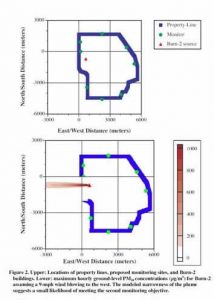 Citizens for Safe Water Around Badger is questioning the Army’s plan for monitoring toxic emissions from open burning explosives-contaminated buildings at Badger Army Ammunition Plant following a technical review by one of its consultants.
Citizens for Safe Water Around Badger is questioning the Army’s plan for monitoring toxic emissions from open burning explosives-contaminated buildings at Badger Army Ammunition Plant following a technical review by one of its consultants.
The air monitoring plan, which was submitted to the WDNR in July, was reviewed by Dr. Charles Gantzer, an environmental engineer based in Minneapolis. Gantzer believes the Army’s plan, which proposes 8 stationary air monitors located at ground level along Badger’s fenceline, will not provide a good assessment of actual air impacts.
“If the wind would blow from one of the proposed burn sites directly toward the center of Bluffview, for example, the plume would miss the proposed monitoring site completely,” Gantzer stated.
“It is highly unlikely that the stationary monitoring stations will be able to detect emissions plumes from any burning at the facility,” Gantzer said. “In order to know exactly what is going into the air, monitors must be positioned in the plume regardless of wind direction. Because the wind is not known before the burn, mobile monitors are required.”
The WDNR said that it plans to supplement the fixed perimeter monitors with its own mobile monitoring; the Department will utilize a truck that is outfitted with air monitoring equipment. According to WDNR staff, mobile monitoring will be done “at the Department’s discretion” and there is no written plan for what pollutants or how often they will test.
Laura Olah, Executive Director of CSWAB, met with WDNR Secretary Scott Hassett on Thursday seeking assurances that the Department will have the resources necessary to sustain long-term monitoring needed to protect human health and the environment during the expected 10 years of open burning at Badger. Hassett promised to get back to the group after he had an opportunity to review the information.
“Now that we know the perimeter monitors will be ineffective, we will be completely reliant on mobile monitoring by the WDNR to measure how pollutants such as lead will be volatilized by the building burns,” Olah said. “We also need this data to quantify deposition on the surrounding soils, surface water, croplands, and wildlife habitat.”

